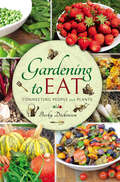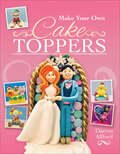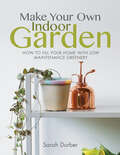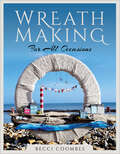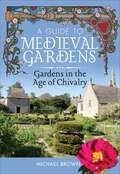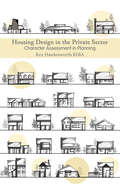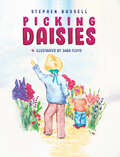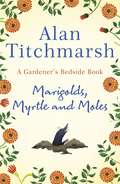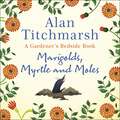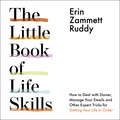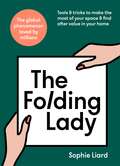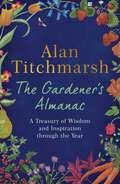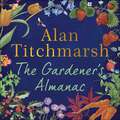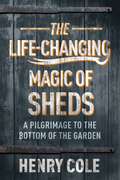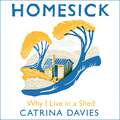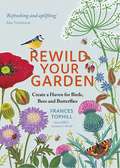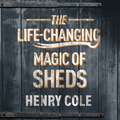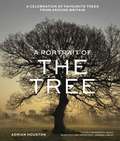- Table View
- List View
Gardening to Eat: Connecting People and Plants
by Becky DickinsonEmbrace a plant-based lifestyle all the way from seed to plate. This inspiring and informative book takes the mystery out of gardening and reveals how to grow an array of fruits and vegetables using simple, organic techniques. Packed with fresh ideas for turning homegrown produce into delicious, nutritious meals, you'll find heaps of no-nonsense recipes created for real people with busy lives and healthy appetites. No fads, no fuss, no fancy ingredients, just real, honest, ethical food. With a passion for connecting people and plants, Gardening to Eat brings the garden into the kitchen. For people who love food and love to know where it's come from.
Make Your Own Cake Toppers (Make Your Own Ser.)
by Darren AllfordBaking is booming! And Cake toppers are the perfect way to truly personalise a cake for any occassion. Whether baking your own or adding to a cheeky shop bought cake, Darren Allford’s easy to follow steps are all you need to create your own cute, quirky mini masterpieces. You’ll discover a variety of styles, some super easy and some more advanced, as well as working with different materials – fondant for a sweet toothed friendly treat or clay for a trusted keepsake. With a few tools, clear instructions and a dollop of patience, YOU can make these toppers and make them well. Is it your tiny superhero’s birthday? Or Mother’s Day? What about your daughter’s wedding or your son’s welcome home gift? Maybe you want a festive friend for the Christmas cake. You’ll find that somebody squealing with joy at seeing themselves perched on top of a cake is incredibly rewarding. Darren is confident that after trying your hand at just a few of the projects in this book, you’ll develop the skills, knowledge and confidence to ride your own creative rainbow and make anything you want. Roll up your sleeves… let's get making!
Make Your Own Indoor Garden: How to Fill Your Home with Low Maintenance Greenery
by Sarah DurberThis book aims to cover the most commonly asked questions by new plant owners and will help people who want to have more greenery in their lives but don’t know where to start. It will advise on the best plant for a variety of home conditions so that everyone should be able to find plants that suit their space. Having and maintaining an indoor garden can be possible for anyone, the book will give you step-by-step guides to creating and designing your own terrariums, cacti & succulent gardens and even kokedamas (Japanese for Moss Ball). It includes descriptions of the equipment needed, and how to find this inexpensively so that the hobby is accessible to everyone. Readers of the book will discover a newfound joy of plants and nature as well as learn a brand-new skill. The book goes into detail about what may be causing damage to a plant, and how to look after plants so that they last. It also focuses on how plants can improve physical and mental health, to encourage readers to fill their homes with greenery for practical and aesthetic reasons. The innate human need to be around nature is called Biophilia, and this book will tap into that need without over complicating things, with the focus on low maintenance, good-looking greenery.
Wreath Making for all Occasions (Make Your Own Ser.)
by Becci CoombesEven a quick walk in the countryside or Sunday stroll along the beach can yield the most interesting and attractive materials for making beautiful decorations for the home. In this book Becci will show you how to form simple wreaths out of foraged elements, with an emphasis on recycling and using sustainable materials. Basic techniques for a variety of seasonal projects are demonstrated, and these can then be used to create smaller garlands, such as napkin rings and candle table centres. Becci focuses on commonly found elements, foraging for plants and foliage and sourcing inspiration from nature; you don’t need to be a trained florist to design gorgeous wreaths and garlands for yourself or your friends. The featured projects will cover wreaths for all seasons, from scented lavender hearts to harvest festival straw circles, and we will explore how to make them from more unusual materials such as pool noodles. The emphasis will be on recycling too, so you will be able to create a garland that can be changed throughout the year to suit your decor and mood.
A Guide to Medieval Gardens: Gardens in the Age of Chivalry
by Michael Brown&“A fascinating account of formal gardens during the middle ages,&” including plants and their uses, features, tools, cultivation techniques, and more (Books Monthly). Medieval gardens usually rate very few pages in the garden history books. The general perception is still of small gardens in the corner of a castle. Recent research has shown that the gardens were larger than we previously believed. This book contains information and pictures that have not been generally available before, including the theory and practice of medieval horticulture. Many features of later gardens were already a part of medieval gardens. The number of plants was limited, but was still no less than many modern gardeners use in their own gardens today. Yet medieval gardens were imbued with meaning. Whether secular or religious, the additional dimension of symbolism, gave a greater depth to medieval gardens, which is lacking in most modern ones. This book will be of interest to those who know little about medieval gardens and to those with more knowledge. It contains some of the vast amount of research that the author carried out to create the medieval gardens at the Prebendal Manor, Nassington, Northamptonshire. The author has tried to use previously unused sources and included his own practical experience of medieval gardening methods that he carried out to maintain the gardens. &“Beautifully illustrated . . . a fascinating read for the armchair gardener as well as the more practical variety . . . The author draws on a wide range of sources: herbals, animal management, medieval manuals, illuminated manuscripts, account books, poems, paintings, and tapestries.&” —The Ricardian Bulletin
Housing Design in the Private Sector: Character Assessment in Planning
by Rex Hawkesworth RibaNever before has house design been a science; it has always been a subjective desire of a rich person who can throw money away to achieve a personal satisfaction of something for him or her. At the opposite end of scale, i.e., housing for ordinary people, you only have to look at Victorian slums to see the outcome - profit. It is not normal for householders to consider the buyer much more than a chance of bathroom or kitchen fittings. Smaller developers are more liable to consider the buyer, provided, of course, the design is straightforward and economical. If densities are met, the architect can probably plot his or her artistic thoughts even more. Therefore, modern housing generally has a traditional look about it. Beyond that, design initiatives are hidden or subtly designed so that the client's vision is not interfered with; a greater depth of understanding is produced if adjoining sites or buildings are taken into account to add sensibility or satisfaction to the design, but this can only be achieved in individual designs and not estates. This is what this book is all about: making the most of the site and its neighbours.
Picking Daisies
by Stephen RussellGemma goes for a short stay in the countryside with her gran and when her parents arrive to collect her, they have a pleasant surprise.
Marigolds, Myrtle and Moles: A Gardener's Bedside Book - the perfect book for gardening self-isolators
by Alan Titchmarsh'Charming miscellany of rhymes and reflections celebrating the garden'CHOICE***The perfect bedside book for the green-fingered - hilarious and touching poems on a gardening theme written and introduced by the nation's favourite gardener and presenter of ITV's Grow Your Own At Home and Love Your Garden, Channel 5's Secrets of the National Trust and with his own show on Classic FM.From touching poems on the peony, the snowdrop and the sweet pea to hilarious verse on Emily the Gardener and the Garden Design Course, this is Alan Titchmarsh's heartfelt and entertaining celebration of his favourite space - the garden.
Marigolds, Myrtle and Moles: A Gardener's Bedside Book - the perfect book for gardening self-isolators
by Alan Titchmarsh'Charming miscellany of rhymes and reflections celebrating the garden'CHOICE***The perfect bedside book for the green-fingered - hilarious and touching poems on a gardening theme written and introduced by the nation's favourite gardener and presenter of ITV's Grow Your Own At Home and Love Your Garden, Channel 5's Secrets of the National Trust and with his own show on Classic FM.From touching poems on the peony, the snowdrop and the sweet pea to hilarious verse on Emily the Gardener and the Garden Design Course, this is Alan Titchmarsh's heartfelt and entertaining celebration of his favourite space - the garden.
Marigolds, Myrtle and Moles: A Gardener's Bedside Book - the perfect book for gardening self-isolators
by Alan TitchmarshThe perfect listen for the green-fingered - hilarious and touching poems on a gardening theme written and introduced by the nation's favourite gardener and presenter of ITV's Love Your Garden, Channel 5's Secrets of the National Trust and with his own show on Classic FM.From touching poems on the peony, the snowdrop and the sweet pea to hilarious verse on Emily the Gardener and the Garden Design Course, this is Alan Titchmarsh's heartfelt and entertaining celebration of his favourite space - the garden.(P) 2020 Hodder & Stoughton Ltd
The Little Book of Life Skills: How to Deal with Dinner, Manage Your Emails and Other Expert Tricks for Getting Your Life In Order
by Erin Zammett RuddyFEATURED ON Deliciously Ella: The Podcast - 10 Ways to De-Stress Your LifeWith tips from leading experts in every field, The Little Book of Life Skills is the ultimate guide to solving the trickiest tasks in your day, making life easier with more time to do things that bring you joy.We all have areas of our lives that make us feel disorganised, unprepared or stressed out. From creating a calmer morning routine to setting yourself up for a good night's sleep, and everything in between, there are easy and proven ways to do things better. Whether you need advice on how to end an argument, iron a shirt or keep your inbox under control, Erin has spoken to experts including Arianna Huffington and Gretchen Rubin, and condensed their wisdom into easy to follow steps for all of life's simple and not-so-simple tasks, such as:- Working from home effectively- Keeping a houseplant alive- Unplugging from your phone- Walking into a room with confidence, and many moreThe Little Book of Life Skills offers simple strategies for streamlining your life. It's the perfect guide for anybody who wants to get their life in order, be more efficient throughout the day and finally learn the best way to fold that tricky fitted sheet!'If you've ever struggled with making a great cheeseboard, exiting a party gracefully or keeping a houseplant alive (um, guilty!), this is the book for you!' - Rachel Ray'A really interesting read that you will turn to again and again.' - Woman's Way
The Lean and Happy Home: More time, less stress. How to get your family life in order
by Eva JarlsdotterIn seven simple steps...Lean removes waste: wasted money, energy, resources.Lean will give you the gift of time.Lean is a set of principles embraced by the most creative and dynamic organisations around the world, and now for the first time, Swedish social entrepreneur Eva Jarlsdotter applies them to family life.Embracing the Japanese 'stream' technique, Eva's seven steps show you how to systematically create and maintain order. From kaizen (continuous improvement) to kanban (visual planning), these principles will bring harmony and a sense of flow to your home. No more time wasted searching for your keys, important paperwork or your internet banking password; no more throwing away food past its sell-by date or arguing about the mess; no more feeling on the back foot all the time. This transformative book will also empower children in the household to take responsibility for their belongings and their schedules, meaning a lot less parental nagging. This modern guide will transform family life from the inside out. The time you save can be channelled into doing things you actually want to do. Be inspired by Eva's own story, understand how Lean works and start to apply her small changes to your everyday life - you will be delighted with the results.
The Lean and Happy Home: More time, less stress. How to get your family life in order
by Eva JarlsdotterMore time, less waste. How to get your family life in order.Lean is a philosophy embraced by the most creative and successful organisations around the world, from Nike to Toyota. Now for the first time, social entrepreneur Eva Jarlsdotter is applying it to family life. LEAN will remove waste: wasted time, wasted energy, wasted money.LEAN will give you the gift of time. This book will show you how to get your life in order, offering a smooth, easy process to bring harmony to your family and home. From coping with never-ending piles of laundry and meal planning to constantly feeling on the backfoot with endless admin from your child's school, this is a modern guide to ensuring your home and family flow. Move over Marie Kondo and Mrs Hinch, Eva offers a 'stream' technique for you to systematically create and maintain organisation - no longer will you spend hours searching for your keys/scarf/paperwork. Instead, that previously wasted energy can be channelled into things you actually want to do. You will stop feeling like you are being chased and take back control into your life. It also empowers children in the household to take responsibility for their belongings and their schedules - kids as young as two can get involved.(P) 2019 Hodder & Stoughton Ltd
Style Sisters: Helping you live an organised & stylish life
by Charlotte Reddington Gemma Lilly'This book is an absolute must-have - add style, organization and a whole sense of calm to your home with their amazing advice.' - Amanda HoldenJust two years ago, busy mums Gemma and Charlotte decided to join their fashion and interior heads together to form a unique service to organise homes with some serious style. In their debut book, Style Sisters, they show us how to stylishly rearrange and declutter our homes to reap the incredible visual and emotional benefits.The Style Sisters will take you through your home room by room, showing you how to declutter, organise and style it with ease. Their aim is to make you feel good, equip you with the timeless approach to cutting out the clutter that weighs you down and make room for clarity, space and zen, amidst a non-stop modern life where it's nearly impossible to fit anything in.Packed with Gemma and Charlotte's top tips and tricks, home hacks, timed detox challenges and a sprinkling of their personal hilarious and heart-warming anecdotes from their job, Style Sisters will put you on the path to living a stylish and organised life.'Style Sisters came into our house, helped make it a home and changed our lives for the better. They are so brilliant at what they do.' - Rochelle Humes'I am obsessed by everything these girlies do. They have so many space-saving and organizing tips that you just don't think of yourself.' - Vogue Williams
The Folding Lady: Tools & tricks to make the most of your space & find after value in your home
by Sophie LiardLaunched in 2020 and already with over 4.3M TikTok followers and over half a million Instagram followers, thousands have fallen for The Folding Lady's realistic approach to making life easier through folding and organising.Here, she brings all her ex-retailer expertise together and offers us a practical and personal guide to help us:* futureproof against the chaos and stress caused by the daily grind* equip us with the tools to create mental and physical 'room' * turn our focus, time and energy to the tasks and 'things' that hold true long-term after value.Sophie teaches us how to fold all our household items, from boxers, leggings and socks to sheets, towels and even napkins and wrapping paper. Anything is foldable and she shares with us the inner joy that folding brings alongside extra tips on organising drawers, desks, snack drawers, cosmetics and more in her bid to help us make life a little easier.'I am all about being real - no rules, no judgement, I'm here to try and make your life a little less messy through folding and organising and some handy home hacks. Take charge of small, simple and achievable tasks and join me as we find your after value in your home' - Sophie
The Gardener's Almanac: A Treasury of Wisdom and Inspiration through the Year
by Alan TitchmarshNational treasure and presenter of ITV's hugely popular Love Your Garden, Alan Titchmarsh brings us his month by month almanac of garden knowledge, facts, advice and inspiration. Here is seasonal advice on what to grow and sow, projects to engage in, as well as wildlife to spot, gorgeous gardens to visit, birds and flowers to celebrate, weather notes, and nature to reflect on in poems, music, and books. A beautifully packaged giftbook with illustrations by Alan himself.
The Gardener's Almanac: A Treasury of Wisdom and Inspiration through the Year
by Alan TitchmarshNational treasure and presenter of ITV's hugely popular Love Your Garden, Alan Titchmarsh brings us his month by month almanac of garden knowledge, facts, advice and inspiration. Here is seasonal advice on what to grow and sow, projects to engage in, as well as wildlife to spot, gorgeous gardens to visit, birds and flowers to celebrate, weather notes, and nature to reflect on in poems, music, and books. A beautifully packaged giftbook with illustrations by Alan himself.
The Gardener's Almanac: A Treasury of Wisdom and Inspiration through the Year
by Alan TitchmarshA month by month treasury of gardening advice, inspiration and knowledge from the nation's favourite gardener.National treasure and presenter of ITV's hugely popular Love Your Garden, Alan Titchmarsh brings us his month by month almanac of garden knowledge, facts, advice and inspiration. Here is seasonal advice on what to grow and sow, projects to engage in, as well as wildlife to spot, gorgeous gardens to visit, birds and flowers to celebrate, weather notes, and nature to reflect on in poems, music, and books.(P) 2022 Hodder & Stoughton Limited
365 Ways to Save the Planet: A Day-by-day Guide to Living Sustainably (365 Series)
by Nergiz De BaereARE YOU READY TO CHANGE THE WORLD?365 WAYS TO SAVE THE PLANET is a full year's worth of daily wisdom, carefully selected to inspire you to take the urgent action our very existence desperately needs. You'll find actions and challenges, surprising facts about the climate crisis, templates for writing to political representatives, scientific explanations of important concepts, popular misconceptions about sustainability, and much more. 365 WAYS TO SAVE THE PLANET goes way beyond predictable sustainability advice about how to recycle. Here you'll discover the small stuff you can do every day to change the world. Because when you get the little things right, the big things follow.
365 Ways to Save the Planet: A Day-by-day Guide to Living Sustainably (365 Series)
by Nergiz De BaereARE YOU READY TO CHANGE THE WORLD?365 WAYS TO SAVE THE PLANET is a full year's worth of daily wisdom, carefully selected to inspire you to take the urgent action our very existence desperately needs. You'll find actions and challenges, surprising facts about the climate crisis, templates for writing to political representatives, scientific explanations of important concepts, popular misconceptions about sustainability, and much more. 365 WAYS TO SAVE THE PLANET goes way beyond predictable sustainability advice about how to recycle. Here you'll discover the small stuff you can do every day to change the world. Because when you get the little things right, the big things follow.
The Life-Changing Magic of Sheds
by Henry ColeThe ultimate guide to sheds from the renowned presenter of Shed and Buried.When it comes to truly finding out who you are and what makes you tick, there is one thing that needs no online subscription to a cloud-based server with a password you keep forgetting. That, my friend, is a shed.Your shed is your refuge. It's the place where you go when you need a break from this mad, crazy world. But a shed can only help you if it's not attached to the house. The minute you attach the shed to the gaff, or confuse the concept of a shed with the concept of a conservatory, or a home office or a Shepherd's Hut, you're doing yourself over. You're never, ever going to get spiritual enlightenment in a lean-to. That's like going to find yourself in Thailand, and staying in the airport.You need to make that pilgrimage to the bottom of the garden. Whether you're walking down a muddy track or crunching along a perfect gravel path, you have to get out of the house. Breathe in the fresh air. Then pull open the door, grapple for the light switch, fire up the heaters and turn on the kettle. Once you're inside the four walls of your shed, you can do whatever you like. You're the king in there.
Homesick: Why I Live in a Shed
by Catrina DaviesThe story of a personal housing crisis that led to a discovery of the true value of home.*'You will marvel at the beauty of this book, and rage at the injustice it reveals' George Monbiot**'Incredibly moving. To find peace and a sense of home after a life so profoundly affected by the housing crisis, is truly inspirational' Raynor Winn, bestselling author of The Salt Path*Aged thirty-one, Catrina Davies was renting a box-room in a house in Bristol, which she shared with four other adults and a child. Working several jobs and never knowing if she could make the rent, she felt like she was breaking apart. Homesick for the landscape of her childhood, in the far west of Cornwall, Catrina decides to give up the box-room and face her demons. As a child, she saw her family and their security torn apart; now, she resolves to make a tiny, dilapidated shed a home of her own.With the freedom to write, surf and make music, Catrina rebuilds the shed and, piece by piece, her own sense of self. On the border of civilisation and wilderness, between the woods and the sea, she discovers the true value of home, while trying to find her place in a fragile natural world.This is the story of a personal housing crisis and a country-wide one, grappling with class, economics, mental health and nature. It shows how housing can trap us or set us free, and what it means to feel at home.This audio edition includes music by Catrina Davies.(P)2019 Quercus Editions Limited
Rewild Your Garden: Create a Haven for Birds, Bees and Butterflies
by Frances Tophill'A refreshing, uplifting and positive look at the true value of a garden.' -- Alan TitchmarshThe perfect book for any gardener looking to get back in touch with their wild side.The rewilding of public spaces and farmland is vitally important to conservation, but how can we support native species and provide rich habitats on our own doorsteps?In this practical, beautifully illustrated guide horticulturalist and Gardener's World presenter Frances Tophill shows you how to plan and maintain a beautiful garden that will attract bees and birds as well as a throng of unsung garden heroes. Whether you have a small balcony or a large open space, discover the joys of welcoming natural ecosystems back into your garden - along with a host of new visitors.
The Life-Changing Magic of Sheds
by Henry ColeThe ultimate guide to sheds from the renowned presenter of Shed and Buried.When it comes to truly finding out who you are and what makes you tick, there is one thing that needs no online subscription to a cloud-based server with a password you keep forgetting. That, my friend, is a shed.Your shed is your refuge. It's the place where you go when you need a break from this mad, crazy world. But a shed can only help you if it's not attached to the house. The minute you attach the shed to the gaff, or confuse the concept of a shed with the concept of a conservatory, or a home office or a Shepherd's Hut, you're doing yourself over. You're never, ever going to get spiritual enlightenment in a lean-to. That's like going to find yourself in Thailand, and staying in the airport.You need to make that pilgrimage to the bottom of the garden. Whether you're walking down a muddy track or crunching along a perfect gravel path, you have to get out of the house. Breathe in the fresh air. Then pull open the door, grapple for the light switch, fire up the heaters and turn on the kettle. Once you're inside the four walls of your shed, you can do whatever you like. You're the king in there.(P)2020 Quercus Editions Limited
A Portrait of the Tree: A celebration of favourite trees from around Britain
by Adrian HoustonA stunning collection of portraits of favourite trees from around Britain by photographer Adrian Houston.---'This is a wonderful book: beautiful and important' - Joanna Lumley'A must-read for all conservationists, environmentalists and nature lovers' - Sir Richard Branson'Adrian's stunning photographs capture the majesty of these iconic trees.' - Geraint Richards, Chair of Action Oak---A Portrait of the Tree is a repository of memories, and a testament to the British landscape. Trees are revealed as religious signifiers, historical landmarks, national emblems.Sparked by a simple question: 'What is your favourite tree?', photographer Adrian Houston discovered a wealth of fascinating stories enmeshed with these giants of the natural world - some of miraculous survival, others of sheltering royalty, or witnessing history, or simply of personal grief and renewal. Adrian photographed each nominated tree looking utterly glorious: spotlit by night, bathed in morning sunshine, wreathed in delicate mist or blazing with autumn colour. From the cedars of Highclere Castle to the plane trees of London, ancient pine woods of the Scottish Highlands to veteran oaks that have stood witness to time; from native stalwarts such as the monumental beech to endangered giant redwoods. This stunning celebration bears witness to the might and majesty of the lungs of the earth - the tree. Includes: Joanna Lumley, Tony Kirkham, Dr George McGavin, Antony Gormley, Jasper Conran, Alice Temperley, Alan Titchmarsh, Sir Richard Carew Pole, the Reverend Lucy Winkett
